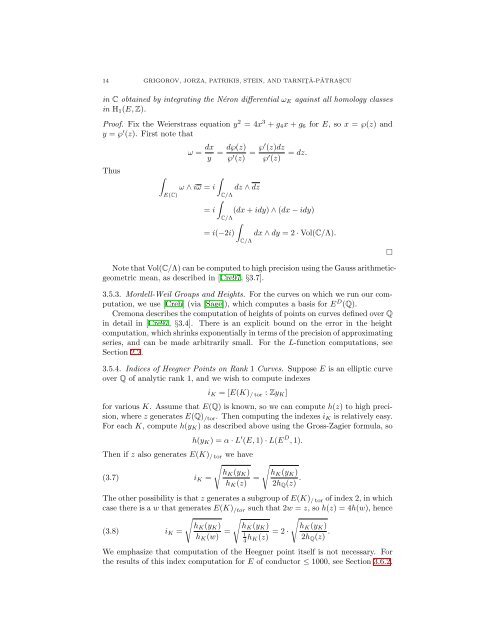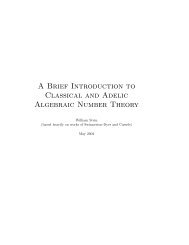COMPUTATIONAL VERIFICATION OF THE BIRCH ... - William Stein
COMPUTATIONAL VERIFICATION OF THE BIRCH ... - William Stein
COMPUTATIONAL VERIFICATION OF THE BIRCH ... - William Stein
You also want an ePaper? Increase the reach of your titles
YUMPU automatically turns print PDFs into web optimized ePapers that Google loves.
14 GRIGOROV, JORZA, PATRIKIS, STEIN, AND TARNIT¸ Ǎ-PǍTRAS¸CU<br />
in C obtained by integrating the Néron differential ωE against all homology classes<br />
in H1(E, Z).<br />
Proof. Fix the Weierstrass equation y 2 = 4x 3 + g4x + g6 for E, so x = ℘(z) and<br />
y = ℘ ′ (z). First note that<br />
Thus<br />
<br />
E(C)<br />
ω = dx<br />
y<br />
<br />
ω ∧ iω = i<br />
<br />
= i<br />
d℘(z)<br />
=<br />
℘ ′ (z) = ℘′ (z)dz<br />
℘ ′ = dz.<br />
(z)<br />
C/Λ<br />
C/Λ<br />
<br />
= i(−2i)<br />
dz ∧ dz<br />
(dx + idy) ∧ (dx − idy)<br />
C/Λ<br />
dx ∧ dy = 2 · Vol(C/Λ).<br />
Note that Vol(C/Λ) can be computed to high precision using the Gauss arithmeticgeometric<br />
mean, as described in [Cre97, §3.7].<br />
3.5.3. Mordell-Weil Groups and Heights. For the curves on which we run our computation,<br />
we use [Creb] (via [Sage]), which computes a basis for E D (Q).<br />
Cremona describes the computation of heights of points on curves defined over Q<br />
in detail in [Cre97, §3.4]. There is an explicit bound on the error in the height<br />
computation, which shrinks exponentially in terms of the precision of approximating<br />
series, and can be made arbitrarily small. For the L-function computations, see<br />
Section 2.2.<br />
3.5.4. Indices of Heegner Points on Rank 1 Curves. Suppose E is an elliptic curve<br />
over Q of analytic rank 1, and we wish to compute indexes<br />
iK = [E(K) / tor : ZyK]<br />
for various K. Assume that E(Q) is known, so we can compute h(z) to high precision,<br />
where z generates E(Q) /tor. Then computing the indexes iK is relatively easy.<br />
For each K, compute h(yK) as described above using the Gross-Zagier formula, so<br />
h(yK) = α · L ′ (E, 1) · L(E D , 1).<br />
Then if z also generates E(K) / tor we have<br />
(3.7) iK =<br />
<br />
hK(yK)<br />
hK(z) =<br />
<br />
hK(yK)<br />
2hQ(z) .<br />
The other possibility is that z generates a subgroup of E(K) / tor of index 2, in which<br />
case there is a w that generates E(K) /tor such that 2w = z, so h(z) = 4h(w), hence<br />
(3.8) iK =<br />
<br />
hK(yK)<br />
hK(w) =<br />
<br />
hK(yK)<br />
1 = 2 ·<br />
4hK(z) <br />
hK(yK)<br />
2hQ(z) .<br />
We emphasize that computation of the Heegner point itself is not necessary. For<br />
the results of this index computation for E of conductor ≤ 1000, see Section 3.6.2.
















